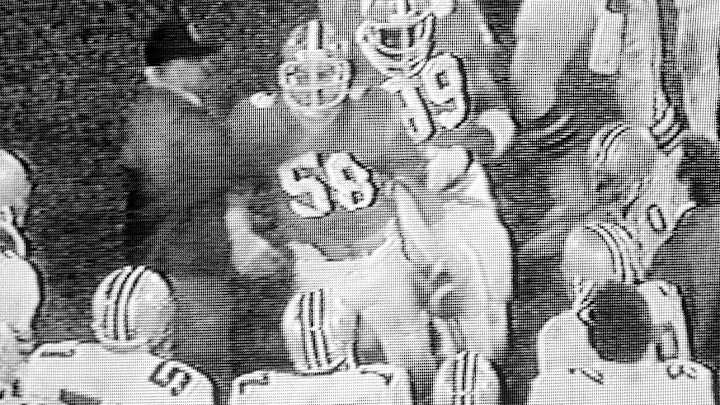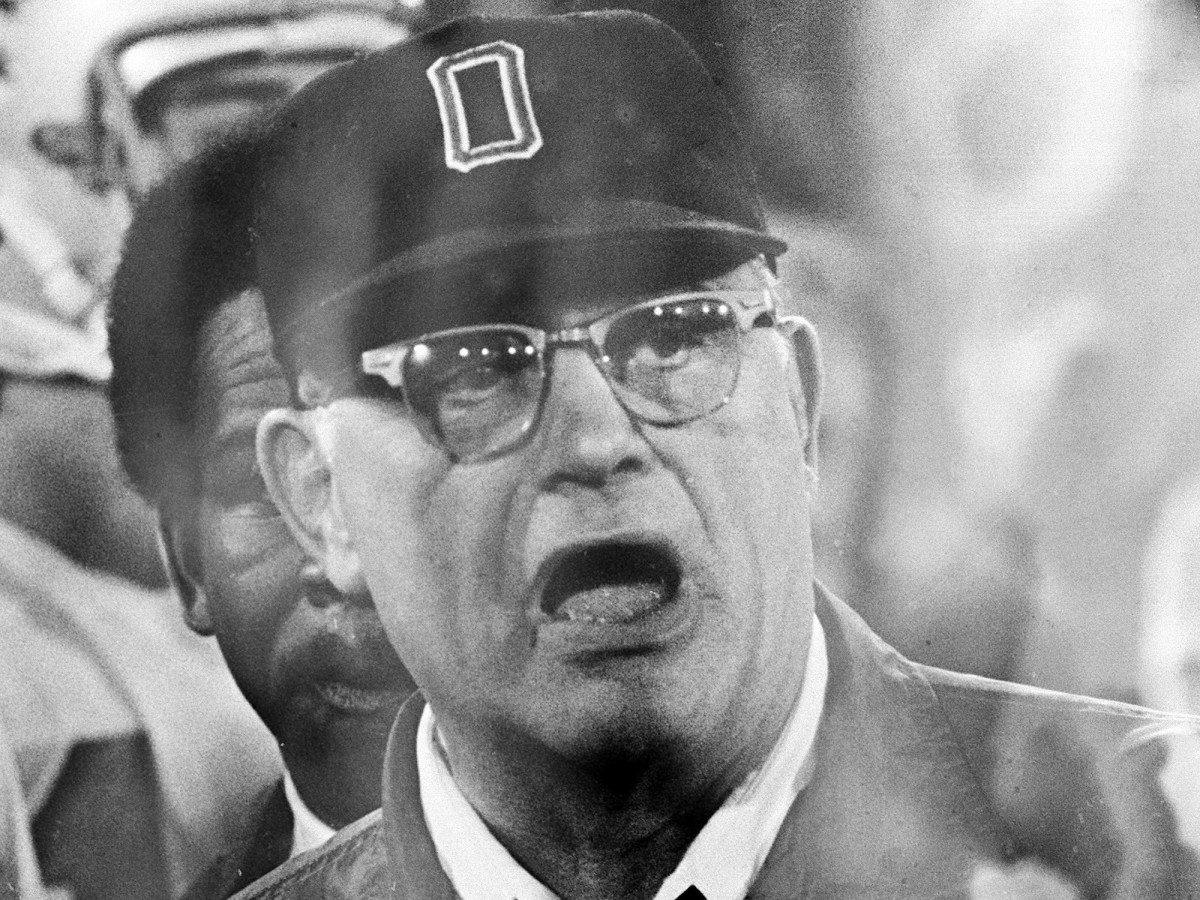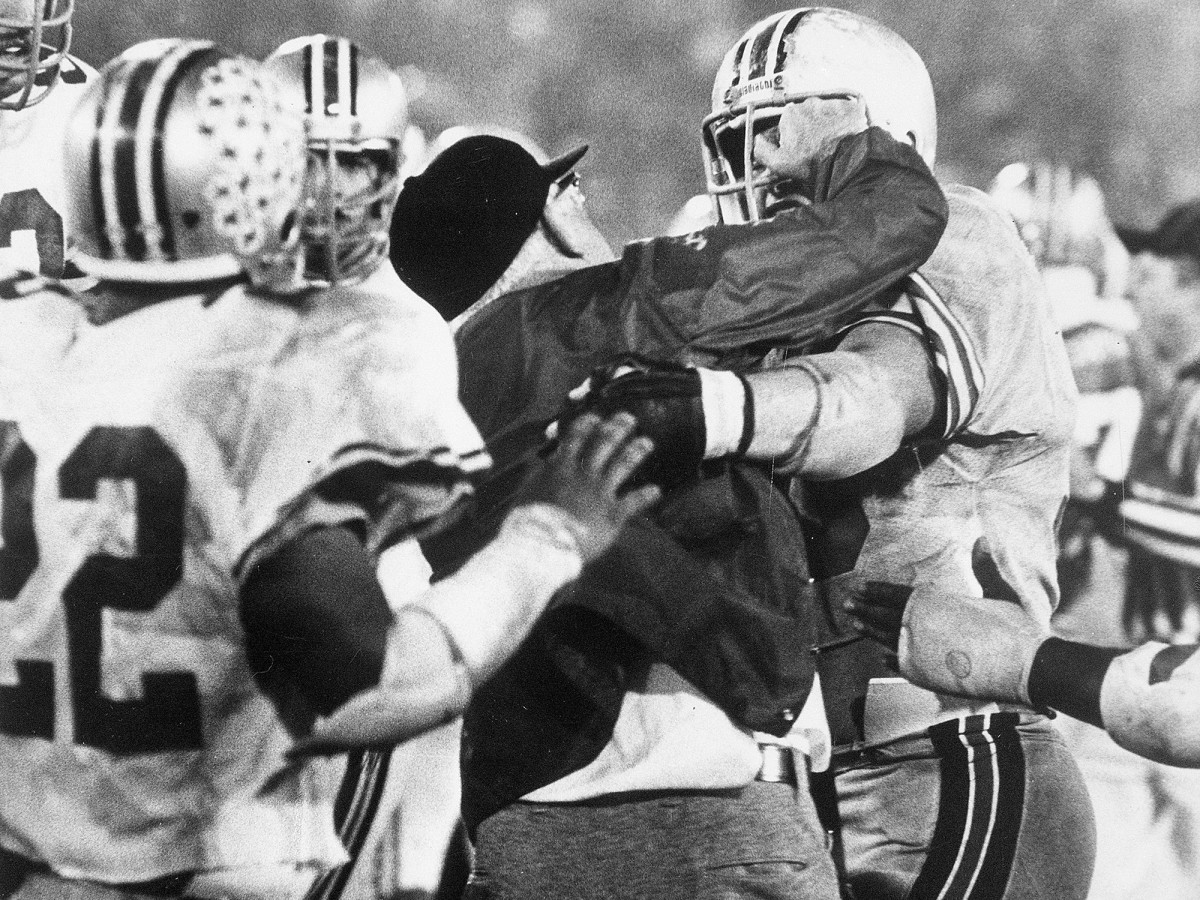Woody Hayes's last stand: Ohio State, Clemson and the punch that ruined Hayes

Adapted from “War As They Knew It: Woody Hayes, Bo Schembechler, and America in a Time of Unrest,” copyright 2008 by Michael Rosenberg
Before Woody Hayes threw the punch that would end his career, Keith Jackson handed him a pair of boxing gloves. This seemed funny at the time. Jackson, the ABC announcer, did it at a luncheon the day before the Gator Bowl between Hayes’s Ohio State Buckeyes and Clemson.
Hayes had a well-earned reputation for losing his temper. There was the time he shoved a cameraman at the Rose Bowl, and the time he destroyed the sideline markers near the end of a loss to Michigan … well, there were a lot of times. His players at Ohio State had seen Hayes lose it at practice so often, some of them even prepared for it. They made sure to stand to his left. Hayes was left-handed; if you stood to his left, he had to take a step back to throw his left hook, and you had a chance to get out of the way.

War As They Knew It
by Michael Rosenberg
Woody Hayes, Bo Schembechler, and America in a time of campus unrest and political upheaval.
Players learned to see Hayes’s fits as more method than madness. They knew the Old Man cared about his players as much as any coach in the country. He regularly turned down raises—he said he was doing his part to fight inflation, but just as likely, he was battling the complacency that money might bring, and he sure as hell didn’t want anybody thinking he was coaching for money. Hayes was adamant that players graduate, and when they did, he preferred they go to law school rather than the NFL. He read Ralph Waldo Emerson and befriended generals and knew more military history than some military historians. The public saw a boor.
Hayes was 65 when he got to the sideline of that 1978 Gator Bowl. He had lost to archrival Michigan three straight years, and people were speculating about the end. Turning Ohio State around seemed unlikely; conceding defeat was not in him. In retrospect, maybe there was only one way the Old Man could go out.
Kickoff was at 9 p.m. on Friday night, Dec. 29, 1978—not that you could see it. There was such a thick fog over the field that the Ella Fitzgerald song “Misty” was played over the stadium loudspeakers. It was so thick that from his seat on the 50-yard line, on the opposite side of the field from the Buckeyes’ sideline, Ohio State President Harold Enarson could barely see what was happening on the field.
The very existence of the Gator Bowl was a sign that college football had begun its transformation from campus spectacle to television show. Offenses were becoming more diverse and exciting. Freshmen were eligible and wanted to play. More teams were allowed to go to bowls, because more bowls meant more programming, which meant more revenue.
Hayes had won at least a share of five national championships with older players running off-tackle plays to perfection, in games that were mostly not televised. Hayes had already become an anachronism in his country—a supporter of America’s military action in Vietnam even after it ended and a friend of Richard Nixon even after he was impeached. Now he was an anachronism in the sport he loved.
He knew he had to adapt, but he did not know how to do it. He recruited highly touted quarterback Art Schlichter to help bring Ohio State into the modern age. But when Art’s dad, Max, demanded that Art be allowed to start and throw 20 passes per game, Hayes agreed. And he was true to his word: Art started right away.
But every time Hayes seemed to embrace what football was becoming, he went back to what he wanted it to be. Against Clemson, Hayes stuck with the run even though it wasn’t working and Schlichter was hot. During one stretch, Schlichter completed 13 out of 14 passes, but Ohio State trailed 17–15. They had one last chance, with less than five minutes on the clock, and Schlichter kept firing: 14 yards to Rod Gerald, 12 to Chuck Hunter.
Ohio State had never had a quarterback like this, partly because the Old Man had never wanted a quarterback like this. He wanted to win with brute force and clinical efficiency. Hayes’s hero, Gen. George Patton, said wars were fought with weapons but won by men. Hayes let others try to invent new weapons. He wanted to mold the best men.

Yet here he was, letting a freshman quarterback fling it around. And it was working. Ohio State faced third-and-five from the Clemson 24, needing at least a field goal to take the lead. Barely two minutes remained. The Buckeyes really didn’t need to pass at that point—a short run would have set up a reasonable field goal to take a late lead. But the kid was playing so well that the Buckeyes decided to throw.
Hayes watched as Art Schlichter dropped back for his 20th pass of the night.
Pass protection had been a weakness for Ohio State all year, but it would not be a problem on this play. The Buckeyes linemen expertly executed their assignments. Poor Clemson noseguard Charlie Bauman tried to make a move to his right and got nowhere. Bauman went left, and Tim Vogler blocked him. Bauman could have rushed for another 15 seconds and he never would have touched Art Schlichter.
Schlichter was in the pocket, going through his progressions. He looked for receiver Doug Donley, but Donley was covered. Next, he looked for Ron Springs, who was open.
Schlichter threw to Springs. He didn’t see Bauman, who was near the line of scrimmage after failing to get to Schlichter.
Bauman stepped to his left, intercepted the pass and took off. Anybody who knew Hayes knew what he was thinking: Goddamn. This was the sort of thing you expected when you got into the passing game. The Buckeyes had done everything right—Schlichter went through his progressions and threw to the right man, the linemen had blocked perfectly—and they still threw an interception. This just didn’t happen when you ran the ball—you handed it to Archie Griffin or Jim Otis or Hopalong Cassidy, the linemen executed their perfect blocks, and you conquered some territory, like Patton’s troops did.
Bauman kept running.
Goddamn, Goddamn …
Who will win the College Football Playoff? Making the case for each team
It was late now—in the game, in the season, in the Old Man’s career and in the night. Hayes had diabetes and heart problems; his health was worst at the end of the season, and his blood sugar was most out of whack at night.
Bauman was finally pushed out of bounds on the Ohio State sideline, right next to the Buckeyes’ 65-year-old head coach.
Goddamn …
Bauman got up, looked up at all those Southerners in the crowd and raised his hands in celebration.
Why, that son of a bitch.
Woody Hayes grabbed the back of Charlie Bauman’s jersey, wound up and punched him in the chest, just below the neck. Bauman looked over at the Old Man like he might have looked at a poodle nipping at his pants. Bauman was in full pads and a helmet; Hayes was in a windbreaker and a black cap, flailing at him. Bauman didn’t strike back. He didn’t even push Hayes away. He just retreated toward his teammates on the field as Hayes kept grabbing at him. Clemson players ran over to the sideline; Ohio State players scuffled with them. One of Woody’s captains, Byron Cato, pulled him away.
From his seat behind the Clemson sideline, Enarson could not see what happened. It was too foggy, too confusing. But Ohio State athletic director Hugh Hindman had a better view. Hindman was sitting in the stands next to his right-hand-man, Jim Jones, who had been Hayes’s old academic counselor—or as Hayes called him, his “brain coach.”
“If he hit that kid, Jim,” Hindman said, “he’s done.”
[youtube:https://youtu.be/pgD1k98Dn8Y]
ABC’s cameraman didn’t even have to move; he was already focused on Bauman when Woody Hayes entered the picture. But up in the press box, Keith Jackson had not seen the punch. All he saw was the melee.
“And we’ve got a big fight going on,” Jackson said on the air. “The officials buried in the middle. Oh, come on now. Quiet down, folks … I don’t know what it was that triggered the fight.”
But across the country, former Ohio State players and coaches were watching the Old Man’s career disintegrate in their living rooms. America would not let him get away with this one—not in 1978, not on national television. One punch had ended it—and not much of a punch, either.
Heck, Woody obviously did not mean to hurt the kid. After all, Hayes punched Bauman with his right hand.
Woody Hayes’s post-game address to his team was mostly about the Civil War. Hayes’s great-grandfather had been killed in the autumn of 1862 at the battle of Antietam, the bloodiest single-day battle in American history. Woody’s great-grandmother had already died before that, so his great-grandfather’s death left his grandfather Isaac Hayes an orphan.
The locker room cleared out fairly quickly. Star linebacker Tom Cousineau didn’t even shower. Defensive coordinator George Hill addressed the media in Hayes’s place. Hill hadn’t even seen the punch—as soon as Charlie Bauman intercepted Art Schlichter’s pass, Hill turned to get his defensive players back in the game.
“Whatever I say would be wrong,” Hill told reporters.
Blowing up the BCS: The oral history of the 2007 Fiesta Bowl
In the locker room, Hindman told Hayes to “be prepared for the worst.” Hindman and most of the coaches were out of the locker room when Hayes sent word that he wanted to see Mark George—Hayes’s student manager, his aide-de-camp.
When George arrived, the Old Man was sitting in a folding chair in the middle of the locker room, his glasses in his hand, his head down.
“Mark,” Hayes said, “I’m going to need your help for the next few days.”
Hayes did not want to go back to the hotel with the Buckeyes. He had embarrassed them enough for one night. He asked George to go get Paul Hornung of the Columbus Dispatch—Hornung was a journalist by title but he was also one of Hayes’s closest friends. When Hornung arrived, he and Hayes sat and talked for 20 minutes. Hornung took some notes, but Mark George, off on the other side of the locker room, could tell this was not a case of a reporter interviewing a coach. It was, like so many other conversations between Hornung and Woody Hayes over the years, a friend talking to a friend. Hayes told Hornung he intended to resign.
The next morning, Hayes called Hornung and gave him the news, on the record, as he had always promised he would when the time came: “I am resigning as of now.” The banner headline blared across that afternoon’s Dispatch:
WOODY HAYES RESIGNS
But he had not resigned. He had talked about resigning; at the Sheraton, Hayes had told both George Hill and Mark George he would resign. And Hayes had told Hornung he would resign. But he had not told Ohio State’s athletic director or president that he would resign.
He had spent several hours in his room at the Jacksonville Sheraton, trying to piece together what had happened, before falling asleep in the sport-coat and tie he had worn to the game. Perhaps, given a day to cool down, he would have gone through with it. But he did not have a day or two. Ohio State wanted Hayes out as quickly as possible. Enarson was worried that the school’s image would be tarnished over an incident in a football game, of all things. Besides, Hayes had come back so many times, from so many incidents, that the administrators did not want to give him a chance to do it again, as unlikely as that might have been.
The case against eight: Why College Football Playoff should stay at four teams
At 2 a.m., Enarson and Hugh Hindman had met at the president’s hotel room in nearby Ponte Verde and agreed Hayes had to go immediately. At 8 a.m., Hugh Hindman went to Hayes’s room and gave him the opportunity to resign. Hayes knew his career was over. He just couldn’t bring himself to end it.
“That would make it too easy for you,” Hayes told Hindman. “You better go ahead and fire me.”
At 10 a.m., Hindman held a press conference at the Sheraton. He announced that “Coach Hayes has been relieved of his duties as football coach at Ohio State. I prefer not to go beyond that.”
Enarson’s plane was diverted to Pittsburgh because of visibility concerns, and he didn’t even wait until he got to Columbus to address reporters. He held a press conference at the Pittsburgh airport.
“There was no difficulty in reaching the decision,” Enarson said. “There is not a university or an athletic conference in the country which would permit a coach to physically assault a college athlete.”
Hayes had finished his 28-year career at Ohio State without ever firing an assistant. The only coach who was fired in Woody Hayes’s coaching tenure was Woody Hayes.

The Ohio State team plane was already in the air when Hindman held his press conference at the Sheraton. Hayes made an announcement over the plane’s loudspeaker.
He said he had three things to tell his players.
The first was that it was New Year’s Eve weekend, and he wanted them to be careful on the roads because there were a lot of crazy people and drunks out there. The second thing was that they had to talk to the brain coach, Larry Romanoff, because classes were about to begin again and he wanted them to get off to a good start. The third thing, Hayes said, was: “I regret to say that next year, I will not be your coach.”
The loudspeaker was so weak that some players couldn’t even hear him.
The punch would come to define Woody Hayes in the way that time reduces a public life to a single memorable fact. Nixon resigned. Jonas Salk developed a vaccine for polio. JFK was shot. Woody Hayes punched a player.
Ohio State lifer Luke Fickell set to bring singular focus to Cincinnati
Hayes became the archetype of the hothead coach who can’t see beyond the playing field. People say he never apologized, but in fact he did, two weeks later, when he fulfilled a previous commitment to speak at the Columbus Area Chamber of Commerce’s annual meeting: “I feel very, very sorry for it because of the wonderful people it’s affected.”
And people say he put himself above his team and his university. That rankles. After he was fired, Hayes went home for a couple hours, then met student manager Mark George at his office.
Woody had a specific request: Throw it all away.
Everything?
Everything.
The pictures with generals and presidents? The coach-of-the-year-plaques, the trophies, the notebooks from seasons past? The letters from President Nixon? The get-well cards?
Everything.
People could say what they wanted about Woody Hayes, but he wasn’t going to take a damn thing he didn’t earn. He wouldn’t even take a t-shirt or one of those block “O” caps he was famous for wearing.
Throw it all away.
George couldn’t believe it. He did something he had rarely done before: He defied the Old Man. How could he throw this stuff out? George put all the items in his car and hauled them over to his mother’s house. They would remain there for the rest of Woody Hayes’s life.
Perhaps the most unusual mementos were the ones Hayes never wanted in the first place. They were in his desk drawers, tossed aside like bottle caps: dozens of uncashed checks, worth thousands of dollars, from charity dinners where Woody Hayes was the featured speaker.
